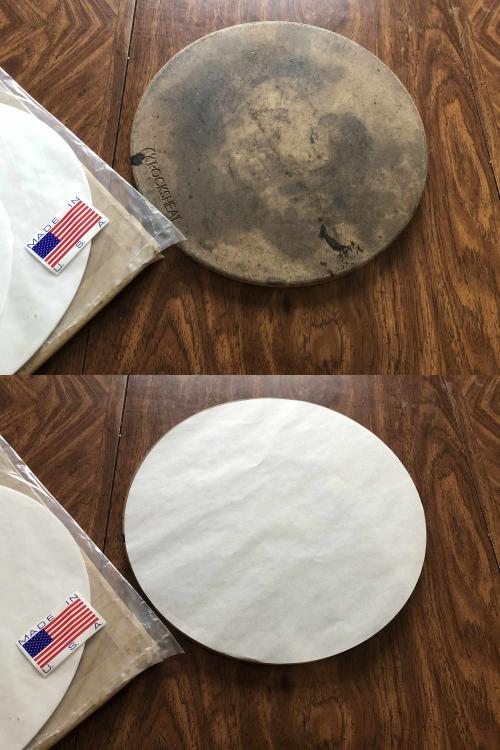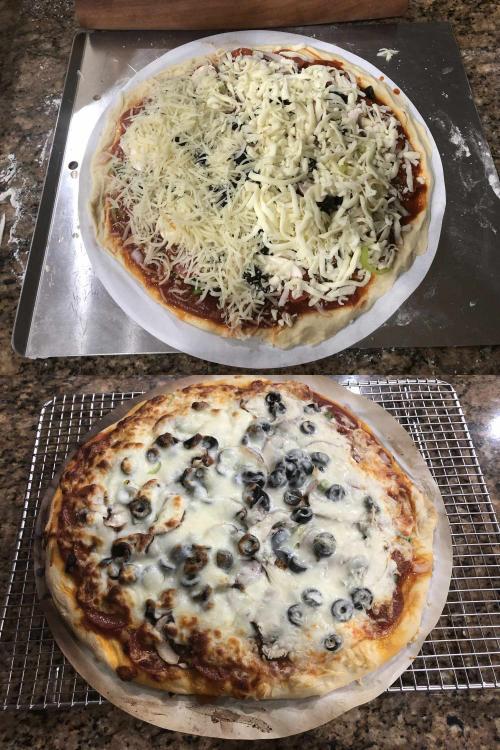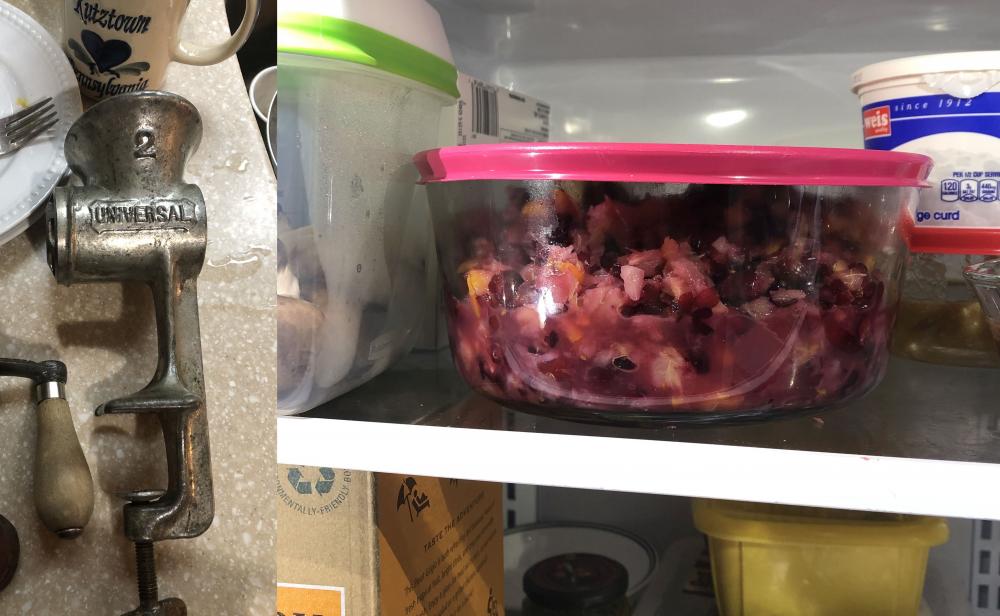-
Posts
1,653 -
Joined
-
Last visited
Content Type
Profiles
Forums
Store
Help Articles
Everything posted by AlaMoi
-
once upon a time, I tried the dusted peel thing.... I suck at that.... so now I use a typical home kitchen oven, a baking stone, an aluminum cookie sheet, and . . . parchment paper! bought some round sheets (Amazon) - cost worked out to about $0.05 more than the same "length" off the el-cheapo grocery store parchment. it has one very convenient side-bennie - while the stone is in the oven getting to untouchable temps, one can see how big to make the pizza... here is stone, here is parchment round I put the dough on the paper, add toppings, use the cookie sheet "peel" in and out of oven. this is my "I love black olives" pizza - always slide off paper to cooking rack - if left on paper the crust goes soggy.... call me chicken, call me anything . . . don't care - parchment works for me!
-
you don't. either put something under to catch the drips, or do the self-clean routine more often.... I only rarely self-clean the baking stone. dark butter stains do no harm and created at 400"F pose zilch comma zero bacterial "danger"
-
our version - 1 bag of cranberries 1 navel orange, with rind 1 can crushed pineapple sugar to taste grind cranberries and orange in old fashion hand cranked grinder add pineapple mix add sugar being the in the Covid-2 state.... we cut back drastically on the number of size of sides this year. DW said she "missed the cranberries" so today we made them to go with leftovers...
-
-
one could open a Dairy Queen above the Arctic Circle and there would be a long line of dog sleds around the local ice berg, with the intent to see what the place is all about . . . on a west coast jaunt, we did an In and Out. decent burger. the rest is hyper hype.
-
I buy the one pound 'roll' of sausage, slice and par-fry. freeze for later nuke&use. used one patty for a 3 egg Denver omelet . . . chopped sausage patty subbed for ham.... had the same issue, wee bit too much 'stuffings' - just gave it another half-rollover and called it 'got et' someday I'll try 1/2 a patty . . . .
-
or one could go lab style . . . https://www.lorannoils.com/1-dram-size/buttered-popcorn-flavor-0892-dram
-
bag or no bag - no way I could sell that level of charred BS to DW.... "fresh" on the stalk is now appearing in the market . . . less char on tap,,,
-
Italy also has long lunches . . .
-
not everything works with a "no knead" approach. I do gadzillions of no knead bread styles. I do Jamie Oliver's pizza dough - which takes a 15 minute kneading + rise. I do 'classic' 16th century German bread recipes that take hand kneading.... basically a stand mixer / dough hook will do the typical kneading exercise - saving the baker his aches and pains.... but - kneaded is kneaded - if you enjoy killing your wrists, mixed not required.
-
we have "city water" - and it was not a 'problem' until the water authority decided to build a new and improved plant. (long terrible taste story short....) installed a charcoal filter for the cold water to kitchen tap, also to the fridge ice maker. $40 for a refrigerator filter every month is absolutely insane. the OEM has an embed chip so none of the generics work.... that I define as a rip off - so I put in the bypass cartridge and a year lasting (big) cartridge filter in the basement. ice makers are uber convenient. in-door with "crushed ice" functions don't work out in the long term (our experience)
-
eggs seem to be the main structure of a fruitcake - akin to flourless cakes - beaten eggs white + stuff.... not much flour used. I would not make 6 of anything without a test run.....
-
there's a couple major different ways to make mac&cheese - and they produce vastly different dishes. the worst, imho, is cook the pasta, dump it in a casserole, sprinkle cheese over it and put it in the oven. I make a roux, thin with milk or cream, season with dry mustard / (other), melt the cheese into the sauce, adjust the sauce consistency then add the cooked pasta. now,,, some eat it straight off the cook top - but I like to oven it for 20-30 minutes...
-
you could try a different detergent - some brands have more silica = sand content - they tend to 'scrub' things a bit better. but be aware! anything with decoration over the glaze will be damaged/destroyed - gilding, ink jet photos, customized class mugs, etc.
-
we got a Bosch as it was supposed to be super quiet a month out of warrranty, the drain pump seal failed. two weeks and couple hundred later, all fixed. a year later, it died. more error codes than one could list. junked it. replaced the Bosch with a Frigidaire - it was 1/2 the cost, and makes half the noise. go figger
-
for KA the heated bowl is an accessory - so you can add it whenever you feel you need it. frankly, in 20+ years I've never had the need. typically in cooking for two, the prep of a small qty of sauce/etc is so quick, doing the proper mise-en-place is far more important - everything portioned out and at the ready... the issue of temp control etc is imho much more a function of experience. it's like bread doughs - not sure if any "new" loaf has ever turned out "perfect" for me on the first try. but after making a recipe 3-4-5 times, you know what to look for and can adapt/adjust on the fly. or proofing/raising dough - there is a time/temp relationship - controlling a rise cycle to the degree and minute is important in a commercial bakery making lots of bread to a schedule. much less important in the home kitchen... my oven has a pre program 'proofing' button - it's too hot - the temp is about 110'F/43'C - close to the yeast kill temp. technology is wonderfully if it actually meets the need. far too often whiz-bang kitchen gadgets don't. same with almost any recipe - if there is no picture of the finished dish, one tends to blunder along not knowing exactly what it's supposed to look like.... gruesse dem Ulmer Spatz!
-
one common 'save' is to add a bit of milk to make up for the lack of water. in "creaming butter & sugar" it is the water that dissolves the sugar. fwiw - the variability in oils - even 'one type' such as coconut - make it very difficult to 'predict a how to' - basically it's experimentation.... a lot of bakers have 'problems' just between USA butter and the higher fat European butters. normally works - but for recipes 'on the edge' it doesn't.
-
the oil will solidify in the chilling - but if it's a coating on the surface (already) - it may now feel greasy vs. oily.... subbing oil is a bit tricky - butter acts a bit like making a roux - the butterfat coats the flour/starch and then the water makes it swell. this obviously doesn't happen with (water free) oils.
-
butter melts at roughly 90-95F coconut oil melts about 20 degrees less - there's a lot of temp variation depending on how refined / etc coconut oil is - even tho a recipe may call for melted butter, when the product cools the butter does not remain melted. I suspect the coconut oil is simply remaining liquid after the cookies cool.
-
well, one can hardly debate the issue of tiny dough ball in huge mixer bowl.... but that said, with a KSM5P and "standard" dough hook, it works. keeping in mind - the dough hook is actually not supposed to tear through / divide / separate the dough at every revolution. first it mixes, then it kneads. banging a lump of dough against the bowl - imitation of what one does on a bench when "kneading" a hunk of dough.... but - - - at a much higher squish-per-minute-rate. my 5 capacity model does one pizza crust or one bread loaf qty without issue. I can envision an 8 qt bowl not hooking up to 'standard' for 'one each' quantities....
-
by tradition, every year prior to (USA) Thanksgiving I go thru my knives and decide which need attention. the heaviest used are a 7" santoku and the 8" chef. DW likes the 6" chef.... so I gave that a complete edge re-do. note: I use a steel at just about every extraction from the block. basically my knives rarely get to a 'dull' stage....but the finish angle does morph over time - and does benefit from a "complete" re-grind/re-set now and then. today I dragged out the Edge Pro - printed out my 'sharpening log' for reference.... used the 220 grit to re-establish the basic edge, + 600 grit to polish - or in the case of the chef knives - double bevel the edges. the santoku I re-ground and polished down to 18 degrees. don't stare - it'll cut you.... this whole escapade took roughly 20 minutes per knife. the drive to post office takes longer.... if one is serious about knife care and sharpness, 'doing-it-yo-self' is highly recommended. it's not hard, it does not take long. note: I don't do or recommend or think about "motorized" sharpening. just isn't necessary - and can be grossly harmful.
-
I've seen the funny business inside and outside of profit/non-profit. people abuse their position, their authority, their privilege. absolutely zilch comma zero question about that. true personally known example: economic downturn all over-night travel required signature authorization from VP or above. then: VP takes private limo to NYC VP flies Concorde/SST to London VP stays overnight in London - one of the most expensive cities at the time. VP takes next day connecting flight to final destination. rules only apply to peons. peons take 12 stop connecting flights to save the company $100 on airfare.... VP fly Concorde and stay in lux overnight accommodations before a direct non-stop connecting flight the next day. Citigroup was the same - thousands for shower curtains in their executive bathroom and thousands for umbrella stands in the foyer of their private office suites.....
-
search "how to sharpen recurved knife" multiple approaches.....
-
something's a tad wonky. the USA site gives nutritional info, and there's 5-7 grams of sugar in the sandwich(es) a single slice of "brand name" type breads has 4 grams. I know many 'chains' adapt their seasonings to local tastes - I wonder if the Irish Subway bread is intentionally made 'extra sweet'









